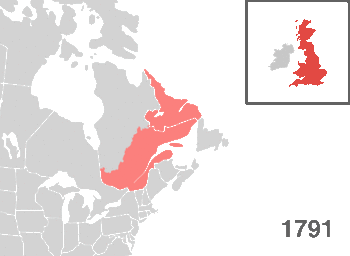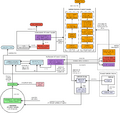Lower Canada facts for kids
Quick facts for kids
Province of Lower Canada
Province du Bas-Canada
|
|||||||||||
|---|---|---|---|---|---|---|---|---|---|---|---|
| 1791–1841 | |||||||||||
|
Flag
|
|||||||||||
 |
|||||||||||
| Status | British colony | ||||||||||
| Capital | Quebec City | ||||||||||
| Common languages | French, English | ||||||||||
| Government | Château Clique oligarchy under a Constitutional monarchy |
||||||||||
| Sovereign | |||||||||||
|
• 1791–1820
|
George III | ||||||||||
|
• 1820–1830
|
George IV | ||||||||||
|
• 1830–1837
|
William IV | ||||||||||
| Lieutenant-Governor and Executive Council of Lower Canada | |||||||||||
| Legislature | Parliament of Lower Canada | ||||||||||
| Legislative Council | |||||||||||
| Legislative Assembly | |||||||||||
| Historical era | British Era | ||||||||||
| 26 December 1791 | |||||||||||
|
• Act of Union 1840
|
10 February 1841 | ||||||||||
| Area | |||||||||||
| 1839 | 534,185 km2 (206,250 sq mi) | ||||||||||
| Population | |||||||||||
|
• 1839
|
700000 | ||||||||||
| Currency | Canadian pound | ||||||||||
|
|||||||||||
| Today part of | |||||||||||
The Province of Lower Canada was a British colony in what is now Canada. It was created in 1791. This happened when Britain divided the old Province of Quebec into two parts. Lower Canada included Labrador and the southern part of modern-day Quebec. It existed until 1841. In that year, it joined with Upper Canada to form the Province of Canada.
Contents
How Lower Canada Was Formed
Before 1791, the British colony in this area was simply called the Province of Quebec. After the American Revolution, many people loyal to Britain moved north. These people, called United Empire Loyalists, mostly spoke English. They settled in the western part of Quebec.
The original French-speaking population lived mostly in the eastern part. To keep both groups happy, Britain passed the Constitutional Act of 1791. This law split Quebec into two new colonies. The western part became Upper Canada, where English laws and customs were used. The eastern part became Lower Canada.
Life in Lower Canada
Lower Canada had a large French-speaking population. They kept their French civil law and traditions. English was also spoken, especially by British settlers and merchants. The capital city was Quebec City.
The economy of Lower Canada was mostly based on farming. People grew crops like wheat. The fur trade was also important. Timber (wood) became a big export, especially to Britain.
How Lower Canada Was Governed
Lower Canada was a colony of the United Kingdom. It had a special type of government. The British King or Queen was the main ruler. They appointed a Lieutenant-Governor to manage the colony.
The colony also had a Parliament. This Parliament had two parts:
- The Legislative Council: Its members were chosen by the British government.
- The Legislative Assembly: Its members were elected by the people of Lower Canada.
This system often caused problems. The elected assembly wanted more power. They wanted to control how the colony's money was spent. But the appointed council and governor often disagreed with them. This led to many political arguments.
The Rebellions of 1837–1838
The disagreements between the elected assembly and the British-appointed government grew worse. Many people in Lower Canada felt they were not being treated fairly. They wanted more control over their own affairs.
This led to the Rebellions of 1837 and 1838. People like Louis-Joseph Papineau led these uprisings. They wanted to change the government and gain more freedom. The rebellions were put down by British troops.
End of Lower Canada
After the rebellions, the British government decided to make changes. They believed that joining Upper and Lower Canada would solve the problems. In 1841, the Act of Union 1840 was passed. This act merged Lower Canada and Upper Canada into one new colony called the Province of Canada. This marked the end of Lower Canada as a separate colony.
Images for kids
-
Constitution of Lower Canada in 1791
-
William Lyon Mackenzie, a leader in the rebellion in Upper Canada
-
Louis-Joseph Papineau, a leader in the rebellion in Lower Canada
See also
 In Spanish: Bajo Canadá para niños
In Spanish: Bajo Canadá para niños





